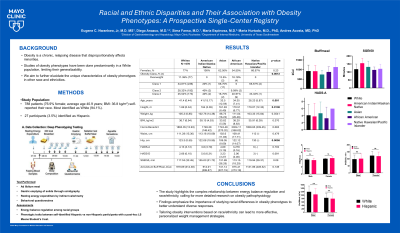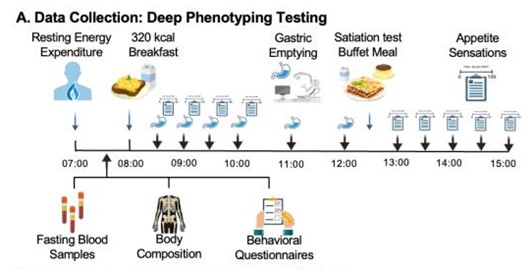Monday Poster Session
Category: Obesity
P3162 - Racial and Ethnic Disparities and Their Association With Obesity Phenotypes: A Prospective Single-Center Registry
Monday, October 28, 2024
10:30 AM - 4:00 PM ET
Location: Exhibit Hall E

Has Audio

Eugene Nwankwo, MD
Mayo Clinic
Rochester, MN
Presenting Author(s)
Award: ACG Outstanding Research Award in the Obesity Category (Trainee)
Award: Presidential Poster Award
Eugene Nwankwo, MD1, Diego Anazco, MD1, Sima Fansa, MD1, Maria Espinosa, 2, Maria D Hurtado, MD, PhD3, Andres Acosta, MD, PhD1
1Mayo Clinic, Rochester, MN; 2Mayo Foundation for Medical Education and Research, Rochester, MN; 3Mayo Clinic, Jacksonville, MN
Introduction: Obesity is a chronic, relapsing disease that disproportionately affects minorities. Studies of obesity phenotypes have been done predominantly in a White population, limiting their generalizability. We aim to further elucidate the unique characteristics of obesity phenotypes in other race and ethnicities.
Methods: Patients with obesity underwent ad libitum meal, gastric emptying of solids through scintigraphy, resting energy expenditure by indirect calorimetry, and behavioral questionnaires. We compared parameters of energy balance regulation among race groups (according to the Office of Management and Budget Standards definition) by using separate multivariate regression analyses including sex, age, and baseline BMI as covariates. We conducted analysis to compare phenotypic traits between self-identified Hispanic vs non-Hispanic participants with a post-hoc LS Means Student’s t test.
Results: 788 patients (76.9% females; 40.9 ± 11.5 years; BMI: 36.8 ±6.8 kg/m2) self-reported their race. 742 participants identified as White (94.1%), 22 as Black or African American (2.8%), 16 as Asian (2.0%), 5 as American Indian or Alaskan Native (AAIN, 0.6%) and 3 as Native Hawaii or Pacific Islander (NHPI, 0.4%). 27 participants identified as Hispanic (3.5%). Baseline characteristics and parameters of energy balance regulation are shown in Table 1. In multivariate regression models, race had a significant effect on calories to satiation (CTS) during an ad libitum meal test (F Ratio: 4.8, p=0.0008), but not on gastric emptying, resting energy expenditure %, or HADS-A. Asian participants had lower CTS compared to Whites (diff: -252.5 kcal, p=0.0005). Black participants also had a lower CTS than Whites (diff: -154.8 kcal, p=0.015). There were no significant differences in the CTS for AAIN (diff: 63.8, p=0.64) or NHPI (diff: 122.6 kcal, p=0.48) when compared to White participants. Hispanics had a lower CTS (899.5 kcal ± 54.9) than non-Hispanics (1010.2 kcal ± 12.3, p< 0.05). No differences were noted between the remaining phenotypic traits.
Discussion: Our study reveals the intricacy between energy balance regulation and race/ethnicity, emphasizing the need for a nuanced study of obesity pathophysiology. These results underscore the need to study racial differences in obesity phenotypes and the importance of tailoring obesity interventions to address diverse phenotypic variations, acknowledging the influence of race/ethnicity for more effective and personalized weight management strategies.

Disclosures:
Eugene Nwankwo, MD1, Diego Anazco, MD1, Sima Fansa, MD1, Maria Espinosa, 2, Maria D Hurtado, MD, PhD3, Andres Acosta, MD, PhD1. P3162 - Racial and Ethnic Disparities and Their Association With Obesity Phenotypes: A Prospective Single-Center Registry, ACG 2024 Annual Scientific Meeting Abstracts. Philadelphia, PA: American College of Gastroenterology.
Award: Presidential Poster Award
Eugene Nwankwo, MD1, Diego Anazco, MD1, Sima Fansa, MD1, Maria Espinosa, 2, Maria D Hurtado, MD, PhD3, Andres Acosta, MD, PhD1
1Mayo Clinic, Rochester, MN; 2Mayo Foundation for Medical Education and Research, Rochester, MN; 3Mayo Clinic, Jacksonville, MN
Introduction: Obesity is a chronic, relapsing disease that disproportionately affects minorities. Studies of obesity phenotypes have been done predominantly in a White population, limiting their generalizability. We aim to further elucidate the unique characteristics of obesity phenotypes in other race and ethnicities.
Methods: Patients with obesity underwent ad libitum meal, gastric emptying of solids through scintigraphy, resting energy expenditure by indirect calorimetry, and behavioral questionnaires. We compared parameters of energy balance regulation among race groups (according to the Office of Management and Budget Standards definition) by using separate multivariate regression analyses including sex, age, and baseline BMI as covariates. We conducted analysis to compare phenotypic traits between self-identified Hispanic vs non-Hispanic participants with a post-hoc LS Means Student’s t test.
Results: 788 patients (76.9% females; 40.9 ± 11.5 years; BMI: 36.8 ±6.8 kg/m2) self-reported their race. 742 participants identified as White (94.1%), 22 as Black or African American (2.8%), 16 as Asian (2.0%), 5 as American Indian or Alaskan Native (AAIN, 0.6%) and 3 as Native Hawaii or Pacific Islander (NHPI, 0.4%). 27 participants identified as Hispanic (3.5%). Baseline characteristics and parameters of energy balance regulation are shown in Table 1. In multivariate regression models, race had a significant effect on calories to satiation (CTS) during an ad libitum meal test (F Ratio: 4.8, p=0.0008), but not on gastric emptying, resting energy expenditure %, or HADS-A. Asian participants had lower CTS compared to Whites (diff: -252.5 kcal, p=0.0005). Black participants also had a lower CTS than Whites (diff: -154.8 kcal, p=0.015). There were no significant differences in the CTS for AAIN (diff: 63.8, p=0.64) or NHPI (diff: 122.6 kcal, p=0.48) when compared to White participants. Hispanics had a lower CTS (899.5 kcal ± 54.9) than non-Hispanics (1010.2 kcal ± 12.3, p< 0.05). No differences were noted between the remaining phenotypic traits.
Discussion: Our study reveals the intricacy between energy balance regulation and race/ethnicity, emphasizing the need for a nuanced study of obesity pathophysiology. These results underscore the need to study racial differences in obesity phenotypes and the importance of tailoring obesity interventions to address diverse phenotypic variations, acknowledging the influence of race/ethnicity for more effective and personalized weight management strategies.

Figure: Figure 1: Schematic representation of methodology, data collection.
Disclosures:
Eugene Nwankwo indicated no relevant financial relationships.
Diego Anazco indicated no relevant financial relationships.
Sima Fansa indicated no relevant financial relationships.
Maria Espinosa indicated no relevant financial relationships.
Maria D Hurtado indicated no relevant financial relationships.
Andres Acosta: Amgen – Consultant. Boehringer Ingelheim – Consultant, Grant/Research Support. Busch Health – Consultant. Currax Pharmaceuticals – Consultant. General Mills – Consultant. Gila Therapeutics – Consultant. Nestle – Consultant. Phenomix Sciences Inc. – Intellectual Property/Patents. RareDiseases – Consultant. Rhythm pharmaceutical – Consultant, Grant/Research Support. Satiogen Pharmaceutical – Grant/Research Support. Vivus Inc – Grant/Research Support.
Eugene Nwankwo, MD1, Diego Anazco, MD1, Sima Fansa, MD1, Maria Espinosa, 2, Maria D Hurtado, MD, PhD3, Andres Acosta, MD, PhD1. P3162 - Racial and Ethnic Disparities and Their Association With Obesity Phenotypes: A Prospective Single-Center Registry, ACG 2024 Annual Scientific Meeting Abstracts. Philadelphia, PA: American College of Gastroenterology.

